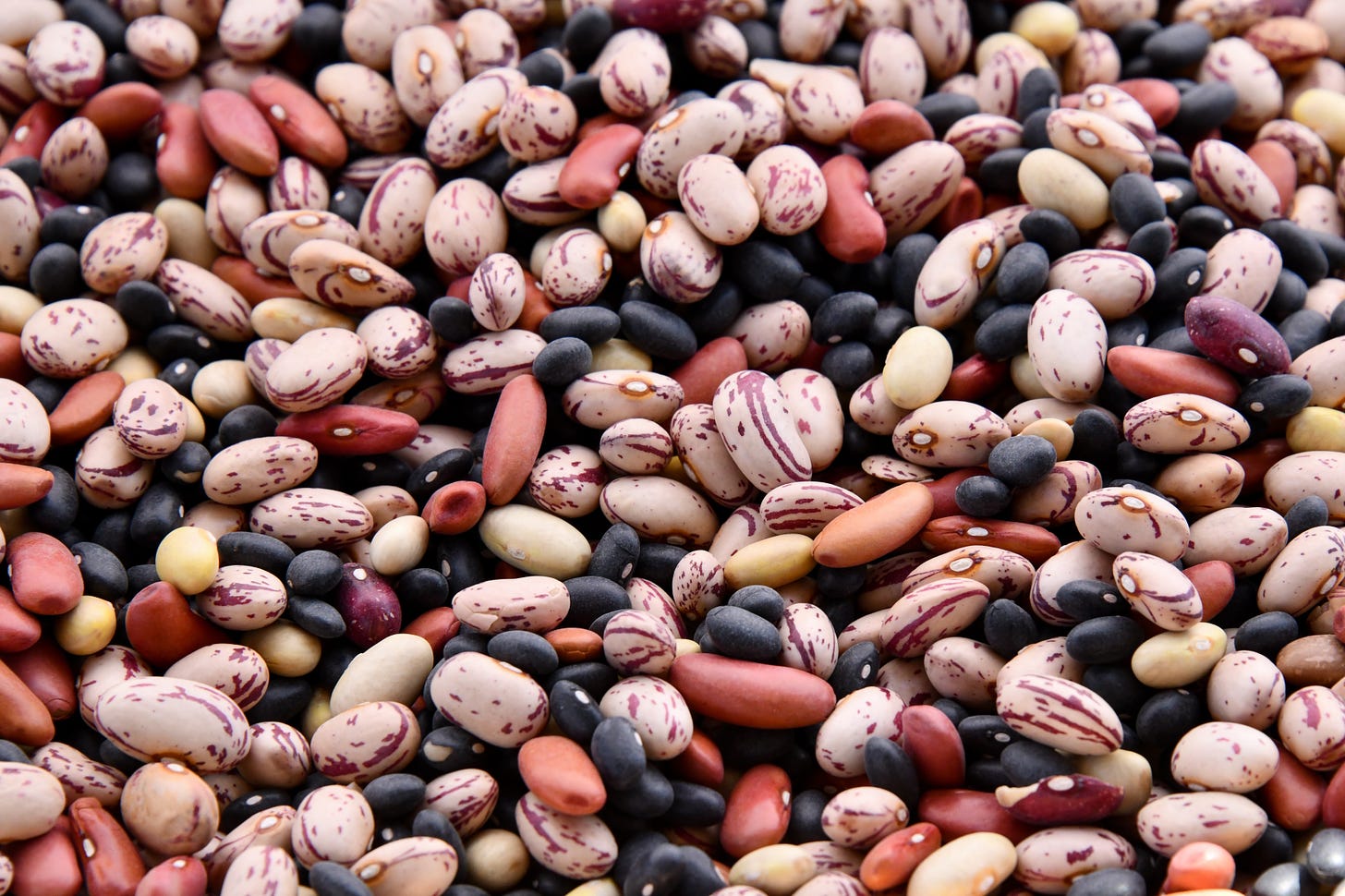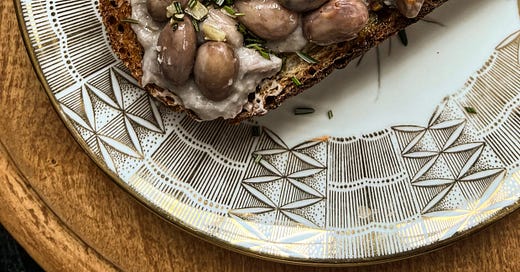Spilling the beans
and the perfect way to cook beans for delicious winter recipes (plus beans on toast!)
Your winter food saviour may be hiding in plain sight.
Regard the lowly bean. With over 400 varieties of beans to be found, it’s not their scarcity that’s the problem. Nor is it their beauty. Their whorls of colour, intricate patterns and uniform shape are evidence of beans’ status as the canvas for Mother Nature’s paintbox.

Beans have fed the world for millennia. Although beans today seem to be most commonly associated with simple fare, a cheap and cheerful source of protein, they have a pedigree of greatness. They’ve been found in the tombs of ancient Greeks and Egyptians, and the fava bean in particular was a major staple of the Mediterranean diet, even before grains. As humans travelled, they brought beans with them, where they quickly became assimilated into local cultures.
Beans may, in fact, be just about the perfect food.
Can the convenience
I’m guessing that if I took a peek in your pantry right now, I’d find a can or two of beans. Canned beans are a miracle of convenience. In one instance, a soup, another an easy dip for noshing, a hearty chili, enchiladas, a salad, a pasta dish. Always the bridesmaid, rarely the bride, beans are content to play a supporting role in a culinary parade of delicious dishes.
While that convenience and speed are a boon for busy days and busy lives, might I suggest that cooking beans from scratch is the perfect Sunday winter afternoon activity? Sure, it takes a bit of planning ahead, but the result is worth the minimal effort.
Cook until done
Like rice, one of the problems with cooking beans from scratch is getting the doneness right. They’re either chalky and hard, cooked unevenly or worst yet, falling apart.
But with the right method, a little patience and some time, you can get perfect beans every time. Two other big pluses: cooked beans can be frozen. Think about having cooked chickpeas ready for hummus, or borlotti beans (also known as cranberry beans), for your favourite slow braised dish. Plus, the cooking liquid, known as bean liquor, is a rich and flavourful substitution for stock, and can also be frozen.
This week I’m sharing the best method for cooking dried beans, from chef Joshua McFadden. Once cooked, you’ll have more than four cups of lovely beans to make any number of delicious dishes. Or just do what McFadden does and slather the beans on freshly grilled country bread. Simple never tasted so good.
Perfect shell beans
Six Seasons, Joshua McFadden
makes 5 cups cooked beans and approximately 3 cups bean liquor
I like to buy fresh borlotti beans in the summer, shell and freeze them so that I have just about fresh beans any time of the year. But don’t fret - this methodology works brilliantly with any dried bean variety.
In the weeks ahead I’ll be sharing some of my favourite winter recipes that feature the glorious bean, including Richard’s take on Corsican beans and greens soup, and a wonderful braised fish dish with a white bean, fennel and tomato ragout.
In the meantime, cook those beans, get your toaster ready, and cosy up to the best winter bite.
Ingredients
4 cups fresh shell beans (from 3 pounds beans in the pod), or 2 cups dried beans
1 big sprig rosemary
1 small whole dried red chile (or red pepper flakes)
1 bay leaf
1 garlic clove, smashed and peeled
Kosher salt
8 to 10 cups water
Extra virgin olive oil
If using dried beans, put them in a bowl or pot and add cool water to cover by a couple of inches. Soak overnight. Drain and rinse; you should have about 4 cups now. Continue with the recipe.
Put the beans, rosemary, chile, bay leaf, garlic, and 1½ teaspoons salt in a large pot (the beans will expand so make sure there’s plenty of room). Add water to cover the beans by 1 inch—about 8 cups for fresh beans, 10 cups for dried.
Bring everything just barely to a boil over high heat, then immediately reduce the heat and adjust so that the beans are simmering, but not actually boiling. Cook uncovered until the beans are about halfway soft—they’ll be soft enough for you to easily bite them with no crunch, but they’ll still be quite dry and crumbly inside. This could take as little as 30 minutes for fresh or 1 hour for dried, so taste early and often.
At this point, add another heaping teaspoon of salt and a generous slick of olive oil. Keep cooking at a gentle simmer and check frequently—the closer you get to doneness, the more frequently you should check. You want to stop cooking the beans when they are very creamy and tender all the way through but not yet mushy or broken up (though a few will split).
When you are just about at that perfect point, move the pot off the heat and let the beans cool in their liquid. They’ll finish softening the last few degrees as they cool. (If you worry that you’ve gone a bit too far and the beans risk getting mushy, as soon as you take them from the heat, transfer them from the pot to a bowl set into some ice water and stir gently to cool things down quickly.)
Once the beans are starting to cool, taste and add more salt if needed, and add another nice slick of olive oil. Once cool, you’re in business. Be sure to keep the bean cooking liquid, which can be easily frozen.
Beans on toast
For this recipe you‘ll need two cups cooked beans and about ¼ cup bean liquor, fresh rosemary, garlic, chili flakes, olive oil and two slices of country bread. You can use canned beans, well rinsed; use water in place of the bean liquor.
Heat ¼ cup olive oil in a pan over medium-low heat. Add one clove minced garlic, two teaspoons chopped rosemary leaves, and a pinch of chili flakes. Sauté until fragrant, about one minute; don’t let the garlic brown. Set aside. Puree 1 cup of cooked beans in a food processor, slowly adding ¼ cup olive oil and some of the bean cooking liquid. The puree should have the consistency of hummus. Add more liquid if needed and season with salt. Brush or drizzle two slices of country bread with olive oil and toast in a 350-degree oven until golden brown. Spread the puree on each toast, then spoon over the rest of the whole beans, lightly pressing them into the puree. Drizzle with the rosemary, chile, and garlic olive oil, and sprinkle with flaky salt. Enjoy!





